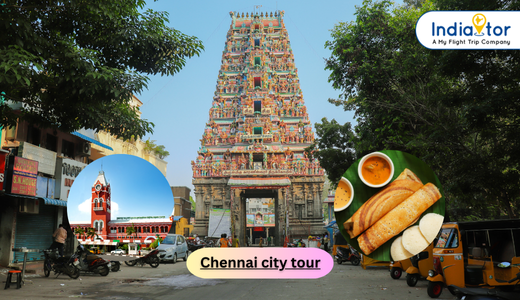-
Table of Contents
Icons of Devotion and Architectural Splendor
Hindu temples are sacred places of worship and are considered icons of devotion and architectural splendor. These temples hold great significance in Hinduism, serving as a place for devotees to connect with the divine and seek spiritual enlightenment. With their intricate designs, elaborate carvings, and vibrant colors, Hindu temples showcase the rich cultural heritage and artistic brilliance of ancient and modern India. These architectural marvels not only serve as religious centers but also attract tourists from around the world, offering a glimpse into the profound spiritual and cultural traditions of Hinduism.
The Significance of Hindu Temple Architecture in Spiritual Practices
Hindu temples are not just architectural marvels; they are also sacred spaces where devotees connect with the divine. The significance of Hindu temple architecture in spiritual practices cannot be overstated. These temples are not merely places of worship; they are icons of devotion and architectural splendor.
One of the key aspects of Hindu temple architecture is its symbolism. Every element of the temple, from its layout to its intricate carvings, is imbued with deep spiritual meaning. The temple is designed to represent the cosmos, with its various levels symbolizing different realms of existence. This symbolism serves as a reminder to devotees of the interconnectedness of all things and the presence of the divine in every aspect of life.
The layout of a Hindu temple typically follows a specific pattern. At the center of the temple complex is the main shrine, which houses the deity. Surrounding the main shrine are various smaller shrines dedicated to other deities. This layout reflects the belief in the multiplicity of gods and goddesses in Hinduism. Devotees can visit each shrine and offer their prayers to the specific deity they feel drawn to.
The architecture of Hindu temples is characterized by intricate carvings and sculptures. These carvings depict scenes from Hindu mythology and serve as a visual representation of the stories and teachings of the religion. The sculptures are not merely decorative; they are meant to inspire devotion and help devotees connect with the divine. The level of detail and craftsmanship in these carvings is truly awe-inspiring and showcases the skill and dedication of the artisans who created them.
Another important aspect of Hindu temple architecture is the use of sacred geometry. The dimensions and proportions of the temple are carefully calculated to create a harmonious and balanced space. This attention to detail is believed to enhance the spiritual energy of the temple and create a conducive environment for worship and meditation. The use of sacred geometry also reflects the belief in the underlying order and harmony of the universe.
In addition to their spiritual significance, Hindu temples also play a vital role in the social and cultural life of the community. Temples serve as gathering places for religious festivals and ceremonies, bringing people together in celebration and devotion. They also serve as centers of learning, where scriptures are studied and religious teachings are imparted. Temples often have associated schools and libraries, further enriching the cultural and intellectual life of the community.
In conclusion, Hindu temple architecture holds immense significance in spiritual practices. The symbolism, layout, carvings, and sacred geometry of these temples all contribute to creating a sacred space where devotees can connect with the divine. The intricate craftsmanship and attention to detail in the architecture are a testament to the devotion and skill of the artisans who built them. Hindu temples are not just physical structures; they are living embodiments of faith and devotion, icons of both spiritual and architectural splendor.
Exploring the Symbolism and Iconography of Hindu Temple Deities
Hindu temples are not just places of worship; they are also architectural marvels that showcase the devotion and artistic skills of the people who built them. These temples are not only significant for their religious importance but also for their intricate designs and symbolism. One of the most fascinating aspects of Hindu temples is the iconography and symbolism associated with the deities worshipped within them.
In Hinduism, deities are not mere statues or idols; they are considered living beings with divine powers. Each deity has a specific form, attributes, and symbolism associated with them. The iconography of Hindu temple deities is a complex system that conveys various aspects of the divine and helps devotees connect with the divine presence.
One of the most common deities worshipped in Hindu temples is Lord Shiva. Shiva is often depicted as a meditating ascetic, with matted hair, a third eye on his forehead, and a serpent coiled around his neck. These symbols represent his transcendental nature, his ability to see beyond the physical world, and his control over the life force energy, respectively. The iconography of Lord Shiva also includes his trident, which symbolizes the three aspects of creation, preservation, and destruction.
Another popular deity worshipped in Hindu temples is Goddess Lakshmi, the goddess of wealth and prosperity. Lakshmi is often depicted sitting on a lotus flower, holding a lotus in one hand and showering gold coins with the other. The lotus symbolizes purity and spiritual enlightenment, while the gold coins represent material abundance. The iconography of Goddess Lakshmi conveys the idea that wealth and prosperity are not just material possessions but also spiritual blessings.
Lord Vishnu, the preserver of the universe, is another important deity in Hindu temples. Vishnu is often depicted with four arms, holding a conch shell, a discus, a mace, and a lotus flower. Each of these symbols represents different aspects of his divine power. The conch shell symbolizes the primordial sound of creation, the discus represents the power of knowledge, the mace symbolizes the power to destroy evil, and the lotus flower represents purity and spiritual enlightenment.
The iconography of Hindu temple deities goes beyond just physical attributes; it also includes the gestures and postures of the deities. For example, Lord Krishna is often depicted playing the flute, symbolizing his ability to attract and enchant devotees with his divine music. The posture of Lord Ganesha, with one leg folded and the other resting on the ground, represents his ability to overcome obstacles and bring success and prosperity.
The symbolism and iconography of Hindu temple deities are not just decorative elements; they have a deeper spiritual significance. They serve as a visual representation of the divine qualities and attributes that devotees aspire to cultivate in their own lives. By meditating on the form and symbolism of the deities, devotees can connect with the divine presence and seek blessings for their spiritual and material well-being.
In conclusion, Hindu temples are not only architectural marvels but also repositories of rich symbolism and iconography. The intricate designs and representations of deities in these temples convey deep spiritual meanings and help devotees connect with the divine. The iconography of Hindu temple deities serves as a visual language that conveys the qualities and attributes of the divine, inspiring devotees to cultivate those qualities in their own lives. Exploring the symbolism and iconography of Hindu temple deities is a fascinating journey into the world of devotion and architectural splendor.
The Role of Hindu Temples in Preserving Cultural Heritage and Community Engagement
Hindu temples have long been regarded as icons of devotion and architectural splendor. These magnificent structures not only serve as places of worship but also play a crucial role in preserving cultural heritage and fostering community engagement.
One of the primary functions of Hindu temples is to preserve and promote cultural heritage. These temples are not just religious institutions; they are also repositories of art, history, and tradition. The intricate carvings, sculptures, and paintings found within the temple walls are not merely decorative elements but are symbolic representations of various mythological stories and religious teachings. These artistic expressions serve as a visual medium through which the rich cultural heritage of Hinduism is passed down from one generation to the next.
Moreover, Hindu temples often house ancient scriptures and texts, which are considered sacred by the followers of the faith. These texts contain valuable knowledge about philosophy, spirituality, and ethical principles. By preserving and safeguarding these scriptures, temples ensure that the wisdom contained within them is not lost to time. They serve as educational institutions, where individuals can learn about their religious and cultural heritage, fostering a sense of pride and identity among the community.
In addition to preserving cultural heritage, Hindu temples also play a vital role in fostering community engagement. These temples are not just places of worship; they are also social hubs where people come together to celebrate festivals, perform religious rituals, and engage in various community activities. The temple premises often include spaces for cultural events, such as music and dance performances, which bring the community together and promote a sense of unity and camaraderie.
Furthermore, Hindu temples serve as centers for charitable activities and social welfare programs. Many temples run schools, hospitals, and orphanages, providing education and healthcare to those in need. These initiatives are not limited to the followers of Hinduism; they are open to people from all walks of life, irrespective of their religious beliefs. By actively engaging in such philanthropic endeavors, temples contribute to the overall well-being and development of the community.
The community engagement facilitated by Hindu temples extends beyond the physical boundaries of the temple premises. Temples often organize religious processions and pilgrimages, which bring people from different regions and backgrounds together. These events provide an opportunity for individuals to connect with each other, exchange ideas, and strengthen social bonds. They also promote tourism and contribute to the local economy, as people from far and wide visit these temples, bringing with them economic opportunities for the surrounding communities.
In conclusion, Hindu temples are not just places of worship; they are symbols of devotion and architectural splendor. They serve as custodians of cultural heritage, preserving and promoting the rich traditions of Hinduism. Moreover, these temples foster community engagement by providing spaces for social and cultural activities, organizing charitable initiatives, and facilitating interactions among people. The role of Hindu temples in preserving cultural heritage and promoting community engagement cannot be overstated. They are not only architectural marvels but also pillars of strength for the communities they serve.Hindu temples are revered as icons of devotion and architectural splendor. These sacred structures hold great significance in Hinduism, serving as places of worship and spiritual connection. With their intricate designs, vibrant colors, and ornate sculptures, Hindu temples showcase the rich cultural heritage and artistic brilliance of the religion. They provide a space for devotees to offer prayers, perform rituals, and seek blessings from the deities. Hindu temples not only serve as religious centers but also as cultural landmarks, attracting tourists from around the world who marvel at their beauty and spiritual ambiance. Overall, Hindu temples stand as magnificent symbols of devotion, architectural excellence, and cultural heritage.



